Henry Kissinger dies at 100 in Kent
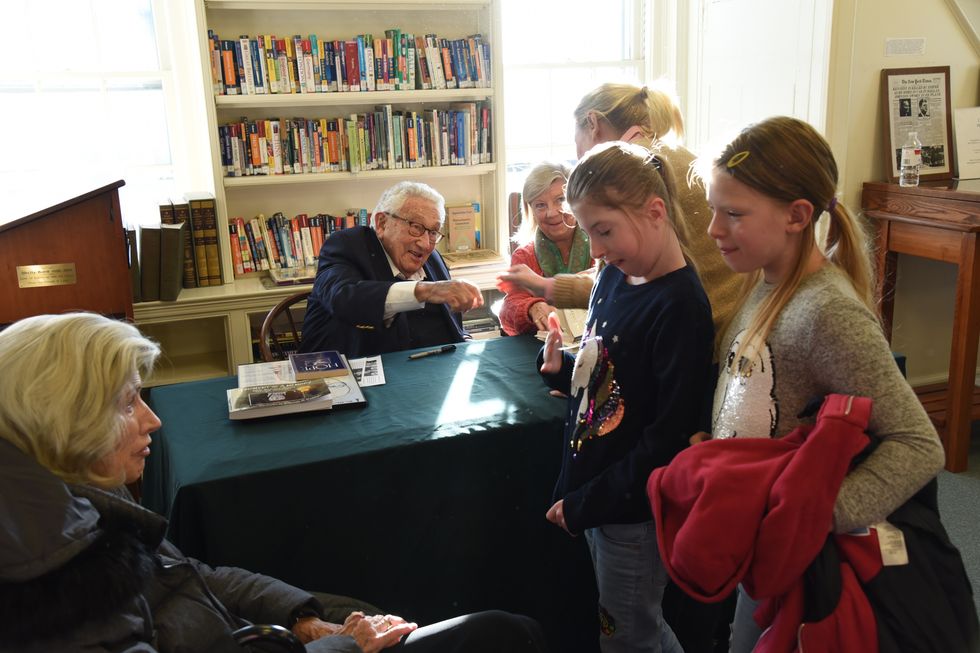
Henry Kissinger signing books in the Kent Memorial Library.
Photo by Lans Christensen

KENT — Henry Kissinger, 100, one of the most controversial figures of the latter half of the 20th century, died at his Kent home Wednesday, Nov. 29, according to a statement from his consulting firm, Kissinger Associates.
The statement said: “He will be interred at a private family service. At a later date there will be a memorial service in New York City.”
He is survived by his wife, Nancy (Maginnes) Kissinger; two children: David and Elizabeth; and five grandchildren.
Kissinger had made a home in Kent since the early 1980s, when he bought the Henderson Blueberry Farm on Henderson Road. He was active in diplomatic circles until the end of his long life, and it was there he met with Chinese Ambassador to the United States Xie Feng on May 26 of this year, the day before his 100th birthday. The pair reportedly had an in-depth exchange of views on China/U.S. relations, and international and regional issues of common interest.
In July, Kissinger traveled to China where he met President Xi Jinping and other Chinese leaders in Beijing.
Despite his larger-than-life impact on the world stage, Kissinger engaged with his fellow townspeople. He supported the Kent Volunteer Fire Department and attended its carnival every year that he was able, where he and his wife would stop for a grinder at the Rod and Gun Club booth before going on to the bingo tent to play with family, employees, and friends such as the late designer Oscar de la Renta.
A good friend of Dolph and Audrey Traymon, he would often broadcast interviews from the Traymons’ Victorian house on Main Street and dine at their restaurant, the Fife ’n Drum.
Early in his Kent residency, he even used his vaunted diplomatic skills to smooth over a local kerfuffle over blueberries growing on his property. There was an outcry from the community about the destruction of the blueberry bushes that had a been a staple of Pick-Your-Own in Kent for years. Kissinger donated the blueberry bushes to Kent School, and they were planted at the girls school campus atop Skiff Mountain, now Marvelwood School. Kent residents have had free access to the bushes ever since.
Earlier in the 2000s, he participated in a program on Russia presented by the Kent Informal Club and the Kent Memorial Library.
Ken Cooper, then-president of the library board, knew the Kissingers well. “There is so much to say [about him],” Cooper said. “Those of us in Kent saw a different side of Dr. Kissinger as a regular, normal presence in our community. He was a regular guy and very gracious to everyone. He was very supportive of the land trust, the library and the fire department. He loved nature and pets — his dog ate supper at the table with him every night.
“When we started the lecture series,” Cooper continued, “he was instrumental in bringing major international figures to speak in Kent. One of striking things I remember is that we were very honored when [civil rights leader] John Lewis came to speak. We had a dinner for him the evening before, and we invited Dr. Kissinger and Nancy to attend. Dr. Kissinger stood up in the middle of the dinner and raise his glass in a toast to John Lewis. He said, ‘You are a Democrat, and I am a Republican, but I want you to know that we are deeply indebted as a country, and I am indebted as a citizen, for your contribution to civil rights in our country.’ I thought that was a very magnanimous thing to do.”
Cooper noted that Kissinger and his wife were a team. “Nancy and Henry were a team, they would finish each other’s sentences,” he said. “They were very affectionate, very fond and respectful of each other. And they made sure they shared credit for anything they did.”
But his time in Kent was just a homely backdrop to his career in what has been termed “the most powerful secretary of state of the post-war era.” His complicated legacy still resonates in this nation’s relations with China, Russia and the Middle East. Kissinger engineered opening relations between China and the United States during the Nixon administration, negotiated America’s withdrawal from Vietnam and a détente with the Soviet Union at the height of the Cold War.
In the 1970s, Kissinger, who described power as an aphrodisiac, was second in power only to President Richard M. Nixon, having joined the Nixon White House in January 1969 as national security adviser and later serving as secretary of state. When Nixon resigned, he stayed on under President Gerald Ford.
He advised 12 presidents, from John F. Kennedy to Joe Biden. His cunning and a ruthlessly practical approach to international relations caused him to be heralded by some and reviled by others. His secret negotiations with China led to Nixon’s most famous foreign policy achievement and was designed to isolate the Soviet Union. It set the stage for today’s complex and sometimes fraught relationship between the two dominant economies. He was the only American to deal with every Chinese leader from Mao to Xi.
His involvement in the United States’ role in Vietnam was deeply divisive. Reportedly never persuaded the United States could win the guerrilla war, he nevertheless guided the Nixon administration in some of its most controversial moves. He was accused of breaking international law by authorizing the secret carpet-bombing of Cambodia in 1969-’70, an action against a neutral nation designed to root out the pro-Communist Vietcong forces operating across the border. The indiscriminate bombing killed 50,000 civilians.
He was known to quip: “The illegal we do immediately. The unconstitutional takes a little longer.”
He negotiated the Paris
Peace Accords that ended American involvement in Vietnam, calling it “peace with honor,” and was awarded the 1973 Noble Peace Prize for his role, but critics argued he could have made the same deal years earlier, saving thousands of lives.
He was the architect of the Nixon administration’s efforts to topple Chile’s democratically elected Socialist president, Salvador Allende. And when Pakistan’s U.S.-backed military was waging a genocidal war in East Pakistan [now Bangladesh] in 1971, he and Nixon ignored pleas to stop the massacre and approved weapons shipments to Pakistan, whose president served as a conduit for Kissinger’s courtship of China. At least 300,000 people were killed in East Pakistan and 10 million refugees were driven into India.
Once an advocate of limited nuclear war, he later reversed his opinion, conceding it might not be possible to contain escalation. By the end of his life, he had embraced the effort to gradually eliminate all nuclear weapons and, at age 95, began to warn against weapons controlled by artificial intelligence.
Courtesy of the Kent Good Times Dispatch, Kentgtd.org
Kissinger was born Heinz Alfred Kissinger to Louis and Paula (Stern) of Fürth, Bavaria, on May 27, 1923. His father lost his job in 1935 when the Nuremberg Laws forbade Jews from teaching in state schools. For three years, Paula Kissinger sought a way to get the family out of the country and, in 1938, the family was allowed to leave Germany when Kissinger was 15. When war broke out, at least 13 of the family’s close relatives died in concentration camps.
The Kissingers settled in Washington Heights, then a haven for German Jewish refugees. His father got a job as a bookkeeper but never fully adjusted to his adopted land. Kissinger dropped the Germanic “Heinz” in high school and adopted the name Henry. In 1940, he enrolled in City College, excelling in his classes, before being drafted by the Army in 1943.
The Army and the war were transformative for the young soldier. He heard a talk about the “moral and political stakes of the war,” and it reportedly changed the direction of his life. He served in Germany as a translator and, in the last months of the war, interrogated captured Gestapo officers and read their mail. He received a Bronze Star for his participation in efforts to uncover sabotage campaigns against American forces.
After the war, Kissinger remained in Germany as a civilian instructor teaching American officers how to uncover former Nazi officers, work that allowed him to crisscross the country. He was alarmed by what he saw as Communist subversion of Germany.
He returned to the United States in 1947 to resume his college education, entering Harvard as a sophomore. He remained at that august institution for two decades, finding fame as a professor before the divisiveness of the Vietnam War drove a wedge so sharply between him and his colleagues he vowed never to return.
Kissinger graduated summa cum laude in 1950, and with the Korean War underway, accepted consulting work for the government that took him to Japan and South Korea. He returned to Harvard to earn a Ph.D. and he and political science professor William Elliott started the Harvard International Seminar, a network that produced a number of leaders in world affairs.
Mr. Kissinger received his Ph.D. in 1954 and Kissinger joined an elite study group at the Council on Foreign Relations, whose mission was to study the impact of nuclear weapons on foreign policy. It was there that he produced his first book, a bestseller titled “Nuclear Weapons and Foreign Policy.”
In it, he argued that if an American president is paralyzed by fear of escalation, the concept of nuclear deterrence will fail. Many scholars panned the book, believing Kissinger had overestimated the nation’s ability to keep limited war limited; to this day scholars refer to it, looking for lessons to apply to cyberwarfare.
The success of the book led Kissinger back to Harvard as a lecturer. His classes were popular, but he was soon immersed in academic politics. He received tenure in 1959, announced by his old champion, Dean MacGeorge Bundy. By 1961 Bundy was national security adviser to John F. Kennedy, but Kissinger was unsuccessful in following him to the White House.
At this time, Kissinger renewed his friendship with Nelson Rockefeller, who then appeared to be a good presidential prospect for 1968. He also met a junior Rockefeller aid, Nancy Maginnes, whom he married years later. Kissinger had earlier married Anneliese “Ann” Fleischer in 1949. They had two children, Elizabeth and David, and divorced in 1964.
Kissinger wrote speeches for Rockefeller denouncing his Republican rival, Richard Nixon. But when Nixon won the nomination, Kissinger accepted an invitation to serve on Nixon’s foreign policy board. He was said to have used his own contacts to funnel information about Lyndon Baines Johnson’s Paris negotiations with the Vietnamese back to the Nixon campaign.
Whether he did or did not, Kissinger was on Nixon’s radar, and after the election, he was appointed national security adviser. Nixon directed Kissinger to run national security affairs from the White House, cutting out the State Department and Nixon’s own secretary of state, William P. Rogers. Kissinger consolidated his power, meeting often with Nixon, often without staff members present, laying the groundwork for his long and convoluted history as one of America’s premier architects of foreign policy.
Courtesy of the Kent Good Times Dispatch, Kentgtd.org
Wes Allyn breaks away from the St. Paul defense for a reception touchdown Wednesday, Nov. 26.
BRISTOL — The Gilbert/Northwestern/Housatonic co-op football team ended the season with a 34-0 shutout victory over St. Paul Catholic High School Wednesday, Nov. 26.
It was GNH’s fourth consecutive Turkey Bowl win against St. Paul and the final game for 19 GNH seniors.
The Yellowjacket defense played lights out, holding St. Paul’s offense to 73 total yards and forcing three turnovers. Owen Riemer and Tyler Roberts each caught an interception and Jacob Robles recovered a fumble.
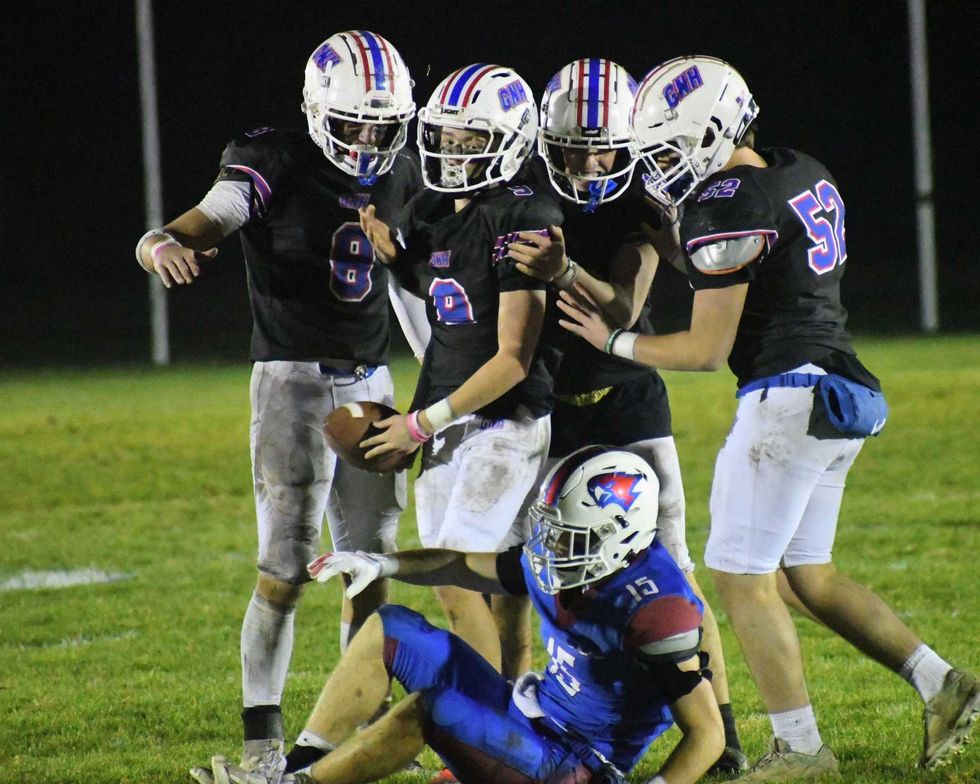
QB Trevor Campbell threw for three touchdowns: one to Wes Allyn, one to Cole Linnen and one to Esten Ryan. GNH scored twice on the ground with rushing touchdowns from Linnen and Riemer.
The game concluded in some confusion. A late run by Linnen ended when he was tackled near the end zone. The ball was spotted at the one-yard line and GNH took a knee to end the fourth quarter with the scoreboard reading 28-0. After the game, Linnen’s run was reassessed as a touchdown, and the final score was adjusted to 34-0.
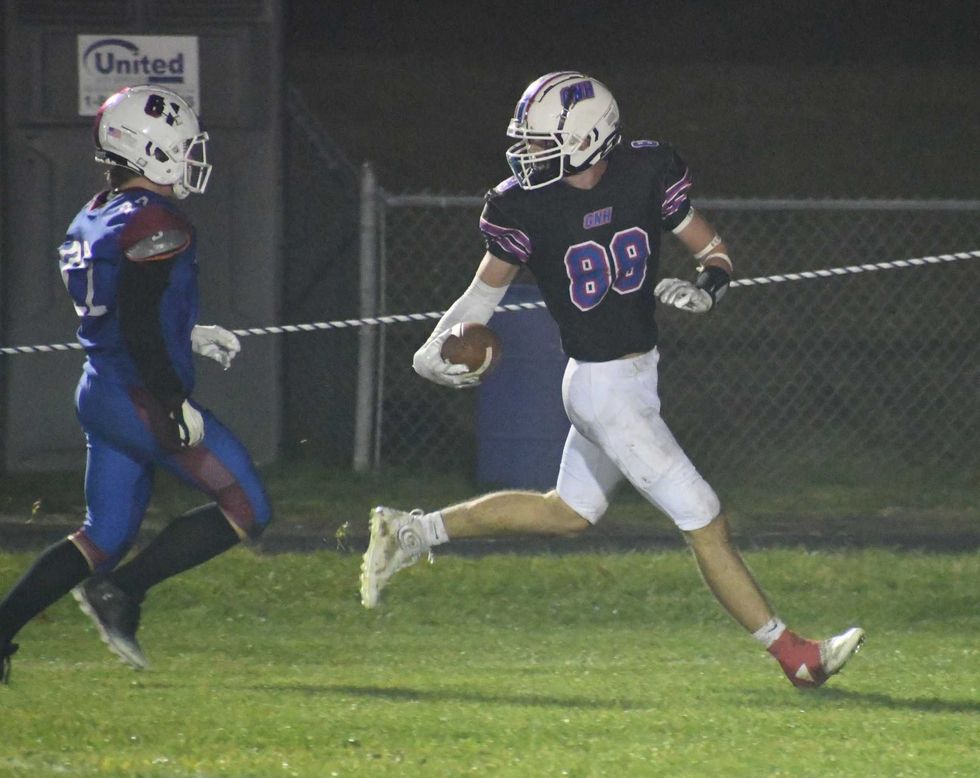
Coach Scott Salius was thankful that his team went out on a high note. “We’re one of the few teams in the state that will finish with a win.” He commented on the “chippiness” of this year’s Thanksgiving matchup. “We have started a true rivalry.”
GNH won four of the last five games and ended with a record of 5-5.
“Battling back from 1-4, huge turnaround. I couldn’t be happier,” said GNH captain Wes Allyn after the win. “Out of the four years I’ve been playing, undefeated on Thanksgiving. No one will ever take that away from me.”
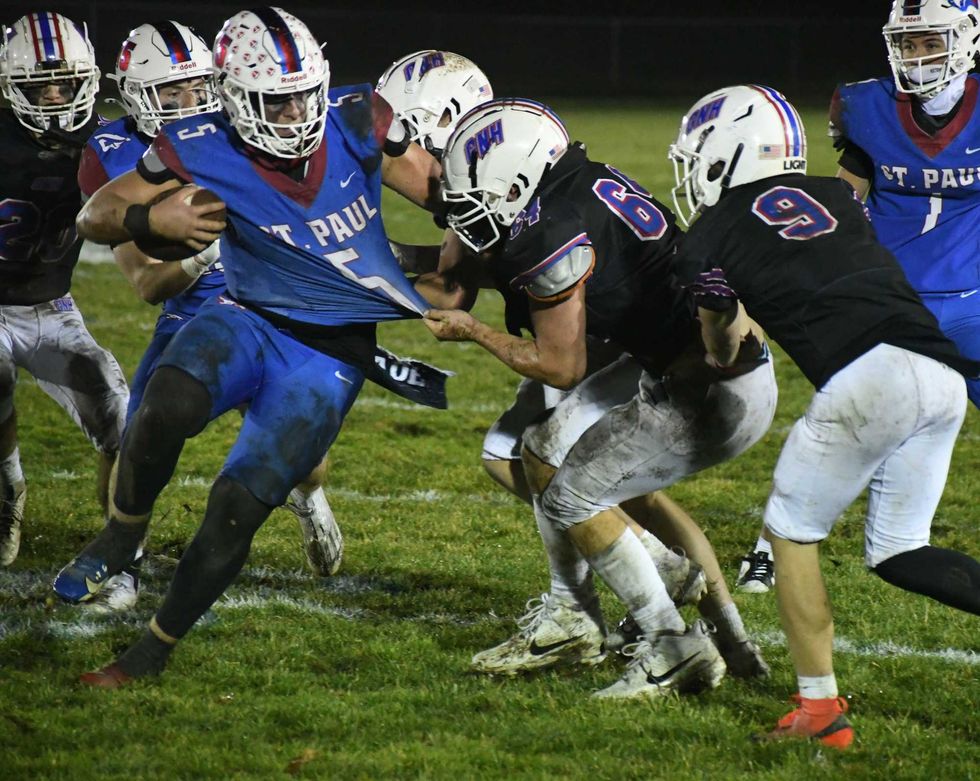
Looking back on his final varsity season, Nick Crodelle said he will remember “practice, complaining about practice, and getting ready for the games. Game day was a lot of fun.”
Hunter Conklin said ending on a win “feels great” and appreciated his time on the field with his teammates. “There’s no one else I’d rather do it with.”
“I’m so thankful to have these guys in my life,” said Riemer. “It’s emotional.”
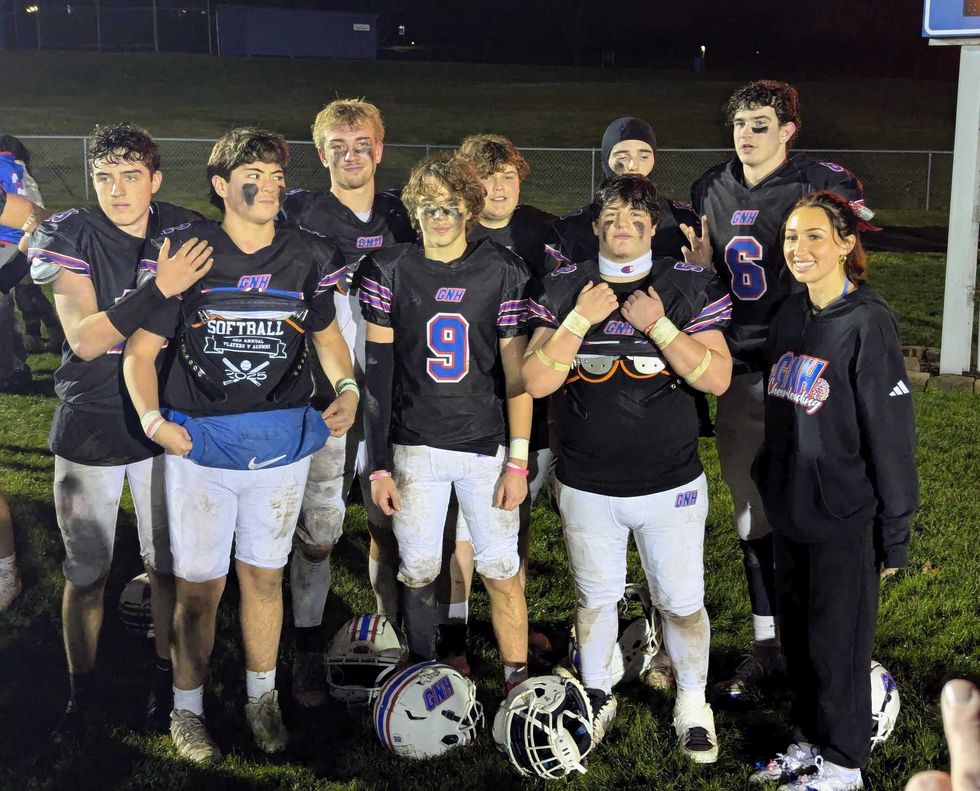
“Once Upon a Time in America” features ten portraits by artist Katro Storm.
The Kearcher-Monsell Gallery at Housatonic Valley Regional High School in Falls Village is once again host to a wonderful student-curated exhibition. “Once Upon a Time in America,” ten portraits by New Haven artist Katro Storm, opened on Nov. 20 and will run through the end of the year.
“This is our first show of the year,” said senior student Alex Wilbur, the current head intern who oversees the student-run gallery. “I inherited the position last year from Elinor Wolgemuth. It’s been really amazing to take charge and see this through.”
Part of what became a capstone project for Wolgemuth, she left behind a comprehensive guide to help future student interns manage the gallery effectively. “Everything from who we should contact, the steps to take for everything, our donors,” Wilbur said. “It’s really extensive and it’s been a huge help.”
Art teacher Lilly Rand Barnett first met Storm a few years ago through his ICEHOUSE Project Space exhibition in Sharon, “Will It Grow in Sharon?” in which he planted cotton and tobacco as part of an exploration of ancestral heritage.
“And the plants did grow,” said Barnett. She asked Storm if her students could use them, and the resulting work became a project for that year’s Troutbeck Symposium, the annual student-led event in Amenia that uncovers little-known or under-told histories of marginalized communities, particularly BIPOC histories.
Last spring, Rand emailed to ask if Storm would consider a solo show at HVRHS. He agreed.
And just a few weeks ago, he arrived — paints, brushes and canvases in tow.
“When Katro came to start hanging everything, he took up a mini art residency in Ms. Rand’s room,” Wilbur said. “All her students were able to see his process and talk to him. It was great working with him.”
Perhaps more unexpected was his openness. “He really trusted us as curators and visionaries,” Wilbur said. “He said, ‘Do with it what you will.’”

Storm’s artistic training began at New Haven’s Educational Center for the Arts. His talent earned him a full scholarship to the Arts Institute of Boston, then Boston’s Museum School, where he painted seven oversized portraits of influential Black figures — in seven days — for his final project. Those works became the backbone of his early exhibitions, including at Howard University’s National Council for the Arts.
Storm has created several community murals like the 2009 READ Mural featuring local heroes, and several literacy and wellness murals at the Stetson Branch Library in New Haven. Today, he teaches and works, he said, “wherever I set up shop. Sometimes I go outside. Sometimes I’m on top of roofs. Wherever it is, I get the job done.”
His deep ties to education made a high school gallery an especially meaningful stop. “No one really knew who these people were except maybe John Lennon,” Storm said of the portraits in the show. “It’s really important for them to know James Baldwin and Shirley Chisholm. And now they do.”
The exhibition includes a wide list of subjects: James Baldwin, Shirley Chisholm, Redd Foxx, Jasper Johns, Marilyn Manson, William F. Buckley, Harold Hunter, John Lennon, as well as two deeply personal works — a portrait of Tracy Sherrod (“She’s a friend of mine… She had an interesting hairdo”) and a tribute to his late friend Nes Rivera. “Most of the time I choose my subjects because there are things I want to see,” Storm said.
Storm’s paintings, which he describes as “full frontal figuratism,” rely on drips, tonal shifts, and what feels like emerging depth. His process moves quickly. “It depends on how fast it needs to get done,” he said. “Sometimes I like to take the long way up the mountain. Instead of doing an outline, I just start coloring, blocking things off with light and dark until it starts to take shape.”
He’s currently in a black-and-white phase. “Right now, I’m inspired by black and white, the way I can really get contrast and depth.”
Work happens on multiple canvases at once. “Sometimes I’ll have five paintings going on at one time because I go through different moods, and then there’s the way the light hits,” he said. “It’s kind of like cooking. You’ve got a couple things going at once, a couple things cooking, and you just try to reach that deadline.”
For Wilbur, who has studied studio arts “ever since I was really young” and recently applied early decision to Vassar, the experience has been transformative. For Storm — an artist who built an early career painting seven portraits in seven days and has turned New York’s subway corridors into a makeshift museum — it has been another chance to merge artmaking with education, and to pass a torch to a new generation of curators.
Le Petit Ranch offers animal-assisted therapy and learning programs for children and seniors in Sheffield.
Le Petit Ranch, a nonprofit offering animal-assisted therapy and learning programs, opened in April at 147 Bears Den Road in Sheffield. Founded by Marjorie Borreda, the center provides programs for children, families and seniors using miniature horses, rescued greyhounds, guinea pigs and chickens.
Borreda, who moved to Sheffield with her husband, Mitch Moulton, and their two children to be closer to his family, has transformed her longtime love of animals into her career. She completed certifications in animal-assisted therapy and coaching in 2023, along with coursework in psychiatry, psychology, literacy and veterinary skills.
Le Petit Ranch operates out of two small structures next to the family’s home: a one-room schoolhouse for animal-assisted learning sessions and a compact stable for the three miniature horses, Mini Mac, Rocket and Miso. Other partner animals include two rescued Spanish greyhounds, Yayi and Ronya; four guinea pigs and a flock of chickens.
Borreda offers programs at the Scoville Library in Salisbury, at Salisbury Central School and surrounding towns to support those who benefit from non-traditional learning environments.
“Animal-assisted education partners with animals to support learning in math, reading, writing, language and physical education,” she said. One activity, equimotricité, has children lead miniature horses through obstacle courses to build autonomy, confidence and motor skills.

She also brings her greyhounds into schools for a “min vet clinic,” a workshop that turns lessons on dog biology and measuring skills into hands-on, movement-based learning. A separate dog-bite prevention workshop teaches children how to read canine body language and respond calmly.
Parents and teachers report strong results. More than 90% of parents observed greater empathy, reduced anxiety, increased self-confidence and improved communication and cooperation in their children, and every parent said animal-assisted education made school more enjoyable — with many calling it “the highlight of their week.”

Le Petit Ranch also serves seniors, including nursing home residents experiencing depression, social withdrawal or reduced physical activity. Weekly small-group sessions with animals can stimulate cognitive function and improve motor skills, balance and mobility.
Families can visit Le Petit Ranch for animal- assisted afterschool sessions, Frech immersion or family walks. She also offers programs for schools, libraries, community centers, churches, senior centers and nursing homes.
For more information, email info@lepetitranch.com, visit lepetitranch.com, follow @le.petit.ranch on Instagram or call 413-200-8081.